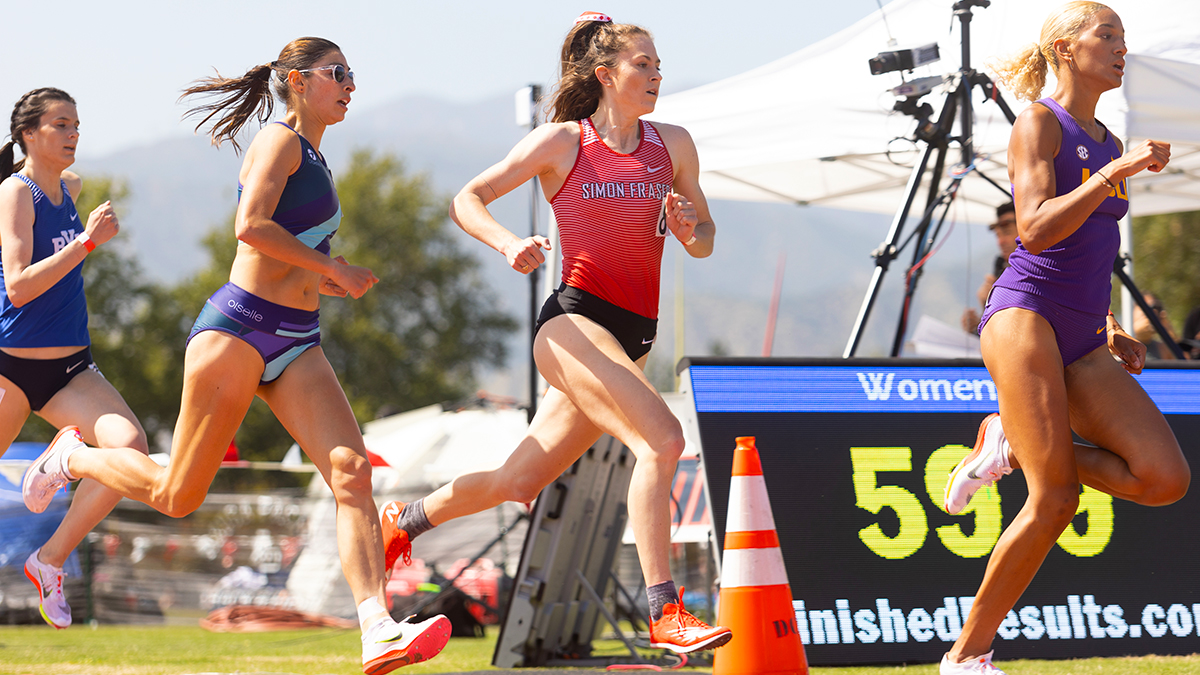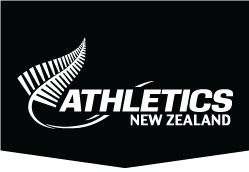News & Updates
Patience is rewarded for Alison as she produces major 800m breakthrough

Alison Andrews-Paul competing at the Bryan Clay Invitational in Azusa, California (Photo: Jacob Thompson)
After six long, frustrating years without bettering her 800m PB it is understandable given her five-second improvement in 2022 Alison Andrews-Paul describes her progression as “stratospheric.”
Since posting a personal best of 2:06.32 when exiting the semi-finals of the World U20 Championships in 2016, the rangy Kiwi has struggled to kick on marred by injury and illness and, initially at least, the wrong recipe for success during her six-year stint in North America.
Yet showing great resilience not to mention enormous self-belief, Alison stubbornly refused to give up on her dreams and this year she finally cracked her near long-standing 800m PB – going on to lower it a total of four occasions – highlighted by a stunning a 2:01.43 performance last month to elevate her to fifth on the all-time New Zealand two-lap rankings.
“I’m still trying to wrap my head around the fact that I am a 2:01 runner,” admits Alison. “It feels so exciting. It’s such an honour to be part of such esteemed company. I felt many people would have thought I was never going to improve (after such a long time between PB’s), but to run 2:01 is very special and it has definitely got me dreaming big.”
Born in Ottawa in Canada, she relocated with her family at the age of five to settle in Masterton. Under the guidance of her dad, Wayne Paul, a two-time Commonwealth Games 400m hurdles representative, Alison saw early athletic success through her school years; culminating with that appearance at the 2016 World U20 Championship 800m semi-finals in Bydgoszcz, Poland.
Just a couple of weeks following this display she started an athletics scholarship at the highly regarded Baylor University in Waco, Texas – the same college which spawned former Olympic 400m champions Michael Johnson, Jeremy Wariner and Sanya Richards-Ross.
Yet for the girl from the Wairarapa it was a challenge adjusting to life in her new environment.
“Texas could not have been more different to New Zealand,” she explains. “I really enjoyed my studies there and the friends I made certainly helped, but it never felt like home. I never felt I had control of things in a way that I would have wanted.”
Training as part of a group for the first time, she enjoyed a solid indoor season in her freshman year only for a stress fracture to strike during the outdoor campaign. Under the coaching of Todd Harbour she enjoyed an “okay” second year at Baylor without producing a breakthrough performance, only for glandular fever to strike at the end of 2018. The illness severely restricted her ability to train and perform how she would have wished in 2019, which led to more frustration for the Kiwi.
Completing her Bachelor of Science in Public Health in three years at Baylor University rather than the typical four years, she knew she wanted to complete her masters degree in public health and this is where Simon Fraser University in British Columbia loomed into view.
The only Canadian college that is part of the NCAA system would allow her to continue her athletics while also offering an enticing academic opportunity and it was here – in the land of her birth – where the dual New Zealand and Canadian citizen found a more conducive environment to delivering her best on the track.
“I have adapted to life here (better), although I wouldn’t say quickly,” she explains. “SFU is a really tough school academically and that first semester was really tough. On the athletics side I had wanted someone who had taken athletes who were not necessarily high school stars but who had become better and had been developed. Brit Townsend, who herself finished seventh in the 1500m final at the 1984 LA Olympics, was that coach. Baylor recruits so many high-level athletes and they have a great programme, but the development aspects there did not work for me.”
Building up a good rapport with Brit in their initial email exchange, she was also impressed by how her new coach was prepared to adopt a patient approach on her recovery from glandular fever and the pair have gelled.
“Brit is such a character,” explains Alison. “If you show up, she will be there for you in whatever capacity you need for any aspect of your life. I don’t know how she balances everything because she has so many people relying on her for so many things.”
Based on a high quality relatively low mileage training model – “I hardly ever train more than 40 miles a week” – has allowed Alison to gradually improve and build up her fitness. Training alongside Tokyo Olympian Lindsey Butterworth, who also reached the World Indoor 800m final in Serbia last month, she is not short of quality training partners and in 2021 she saw the green shoots of recovery.
Despite athletes at Simon Fraser University being denied the opportunity to hop over the border to compete in the US last year because of the Canadian Covid restrictions, she competed on a handful of occasions and posted her fastest 800m for five years with a 2:07.07 clocking. Later in a mixed race she ran a 2:06.41, a time that was within a tenth of a second of her long-standing lifetime best. But it wasn’t necessarily the time, but the way she felt during that competition in Victoria which filled her with confidence.
“When I ran that 2:06 at World Juniors, I thought that was the best I could have done. But when I ran that 2:06 I knew there was more to come.”
Enjoying a positive cross country season at the end of last year – she finished a solid 76th at the NCAA Division II Cross Country Championships – she entered the 2022 indoor track season optimistic of some good performances.
A 1000m PB of 2:44.54 in Boston in January represented a promising start, although the day before her opening indoor 800m outing for the year in Spokane, Washington she suffered a blip after a running what she describes as a “God awful” run over the mile in the distance medley relay.
“I had to make a big mental shift for the 800m the next day,” she explains. “Thankfully, one of my team-mates Addy Townsend, daughter of my coach, offered to pace the race and she ran to 500m which definitely helped. I managed to finally run a PR (personal record) of 2:05.75 – my first for six years – and I remember I cried after that race like I never have when setting other PRs. To finally set a PR after all that time believing it always was possible was great, although I immediately wanted to go faster.”
Alison did not have to wait long. Just ten days later on her return to the indoor track at Spokane she dropped a 2:05.09 for victory in her conference championships in championship record time before heading to the NCAA Division II Championships in Pittsburg, Kansas as the fastest in the field for the 800m. However, in the 800m heats there she admits to “running like an idiot.”
“I ran a dumb race and I was just lucky to be in a good enough shape to make it through after tripping up with 150m to go,” she says.
Yet after a chat to Brit, Alison was advised not to lead it out over the first lap of the final. Heeding her coach’s advice, the tactic was to pay dividends in the final.
“Two girls on the outside of me really went for it over the first 200m,” she explains. “The fast pace worked out well as it gave me space to run, so I just slotted in behind them. I did not panic at all and in the final 200m I was ready to fight with the other girls. I was in shape and came away with the win in 2:04.04. It was really neat – one of the coolest experiences of my life.” The time was another championship record and the third-fastest in NCAA Division II all-time for the women’s 800m indoors.
After opening her outdoor campaign with a 1500m PB of more than five-and-a-half seconds in San Francisco (4.21.52) and buoyed by her indoor achievements and a slick 4x400m split of 53.6, she knew a PB was on the cards for the 800m. But even she was taken aback by the size of the improvement she made last month in Azusa, California. At the Bryan Clay Invitational she finished fourth – after going through the bell in a rapid 59 seconds – in a huge new PB of 2:01.43 and NCAA Division II record for the distance. Only New Zealand record-holder Toni Hodgkinson, Angie Petty, Nikki Hamblin and 1964 Olympic 800m bronze medallist Marise Chamberlain have ran quicker for the distance in what was a spectacular breakthrough performance.
Describing the performance as a “stratospheric” improvement there is little doubt it has altered her thinking for the remainder of the campaign – where her main target will be adding the NCAA Division II outdoor 800m crown to the indoor title she snared last month.
“To do well in the NCAA champs is definitely the big goal and for my final race of the season I plan to compete at the Canadian Championships in June,” she says. “This season has far exceeded my expectations and I hope to see the season out in style.”
Graduating in August this year will also bring about the climax of her six-year North American collegiate adventure. Yet the burning question given the nature of her sizeable improvement is what next?
“I definitely plan to stay with Brit as my coach and continue to be based in Vancouver for the most part,” explains Alison. “But I haven’t ruled out next year maybe running some of the New Zealand domestic season. It will be cool to do the Classic series because I’ve missed out on them for so long.
“I would love to make the Olympic Games team one day, although I have had to let those goals go a little to continue to enjoy the sport. But if it happens, then awesome. The long-term plan is to compete at the highest level I can. If I’m lucky enough to be selected in future to run for New Zealand, then I will do everything I can to make my country proud on the world stage.”
